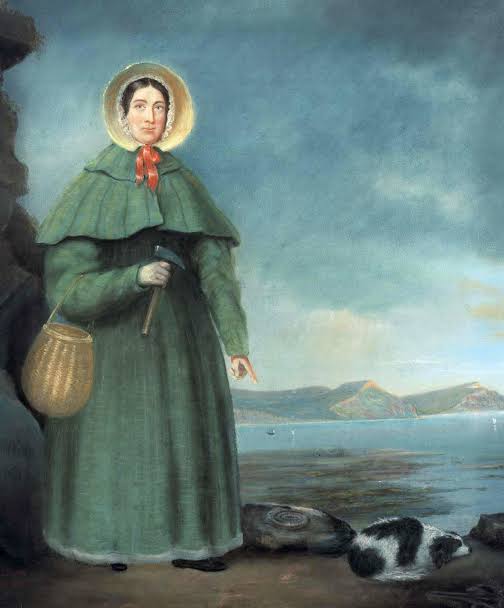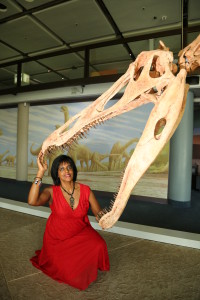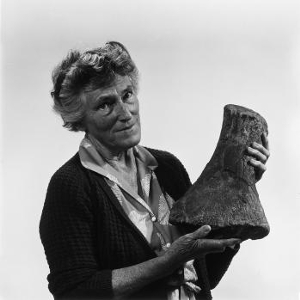
Fossils have been found and studied since the early 17th century and women paleontologists have usually taken a back seat to men in the field. Today, in the United States, only about 20% of paleontologists are women. But even though women don't dominate in their numbers, they more than make up for it in achievements.
Take Mary Anning, for example. She is considered to be the first paleontologist for her work on fossils in England. This Women’s History Month, we honor Mary Anning and other notable women who "rock" the world of paleontology.
Mary Anning | 1799-1847
Mary Anning grew up on the Jurassic Coast of England. From a young age, she went out to collect fossils with her father, finding the first ichthyosaur at just 12 years old. She also found the first two mostly complete plesiosaur skeletons, the first pterosaur located outside of Germany, and many other fossil firsts. Anning also pioneered the study of coprolite and belemnite fossils, the first to correctly identify them as feces and ink sacs.
Despite her incredible finds, Anning was often discriminated against as a woman, denied entry to the Geological Society of London and even had her finds disputed and challenged. Anning passed away in 1847, but she continues to be recognized for her work. Her fossils are displayed at the National History Museum of London today, and in 2010 she was named one of the top 10 most influential women in the field of science in Britain. With new dinosaurs, fields of study, and even nursery rhymes, (The rhyme "She sells seashells by the seashore" is purported to be about Anning), Anning’s firsts have paved the way for much of what we know about paleontology today.
Sue Hendrickson | 1949-present
After beginning in boat maintenance and sailing, Sue Hendrickson knew that diving for tropical fish was the perfect career for her. That is, until one day when her friend showed her a fossil trapped in amber, and she decided that locating fossils in an amber mine was her dream job. After providing many local universities and museums with valuable amber fossils, Hendrickson was invited to a whale fossil dig in Peru and then, she knew she was destined to be a paleontologist.
While in Peru, she was asked to join a dinosaur dig in South Dakota and luck struck. In 1990, Hendrickson discovered the most complete T. rex found to date-with about 90% of the bones excavated and accounted for. You may recognize Sue Hendrickson as the namesake for Sue the T. rex which is now on display at the Field Museum of Natural History in Chicago. You can read Sue’s story in her own words in her book Hunt For the Past and in numerous other books she's written for adults and children.
Anusuya Chinsamy-Turan 1962–present
A veritable powerhouse of South African paleontology is Anusuya Chinsamy-Turan. But her career as a paleontologist began after a dubious start. As an Indian South African in the time of apartheid, Chinsamy-Turan's options for a college education were limited. Hailing from a family of educators, her heart was set on becoming a science teacher, but non-white students in South Africa were required to provide a good reason for wanting to study at a white university.
In a "little white lie" on her admission papers, Chinsamy-Turan wrote that she wanted to study palaeoanthropology at the University of the Witwatersrand, even though she fully intended to teach science. As fate would have it, she grew to love paleontology and has gone on to focus her work on non-avian Dinosaurs, Mesozoic birds, Permian and Triassic therapsids from the Karoo basin of South Africa, and a variety of Cenozoic vertebrates from the West Coast Fossil Park. Chinsamy-Turan has also helped find and name new species including Nqwebasaurus, Aardonyx, Sefapanosaurus, Sapeornis, Changuraptor, Gobiraptor and Serikornis.
Aside from an impressive array of finds, Chinsamy-Turan's has received an extensive list of awards and appointments, including Fellow of the Royal Society of South Africa and World Academy of Sciences, Distinguished Women Scientist Award and South African Woman of the Year Award, and many, many more. She has written academic books (such as Forerunners of Mammals) popular science books (Dinosaurs and Other Prehistoric Life) and hundreds of journal publications. Chinsamy-Turan is currently a paleobiologist based at the University of Cape Town.
Joan Wiffen | 1922-2009
Joan Wiffen of New Zealand put her country on the paleontological map during her lifetime. As a self-taught paleontologist, she didn’t know that scientists believed that New Zealand was too isolated to have dinosaurs. Wiffen handily proved everyone wrong in 1975 when she discovered the tail bone of a theropod dinosaur.
After that first find, Wiffen went on to continue excavating and found fossilized remains of Hypsilophodonts, Pterosaur,s Ankylosaurs, Mosasaurs, Plesiosaurs and Titanosaurs. Although her first paper was published in 1980, she was told to keep her gender a secret, but word soon got out about New Zealand’s “dinosaur lady.” She wrote about her discoveries in Valley of the Dragons: The Story of New Zealand's Dinosaur Woman. Women in paleontology are well-represented in children’s books and Wiffen is no exception. You can read about her in Dinosaur Hunter: Joan Wiffen's Awesome Fossil Discoveries
Wiffen went on to receive an honorary doctorate and CBE, in addition to the Morris Skinner Award and other awards from the New Zealand Geological Society. Today, you can see all her finds at the New Zealand Geological Society and at GNS Science.
All images subject to copyright.















